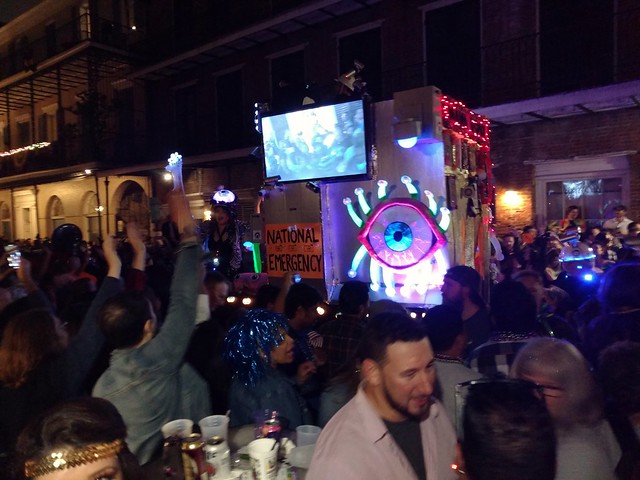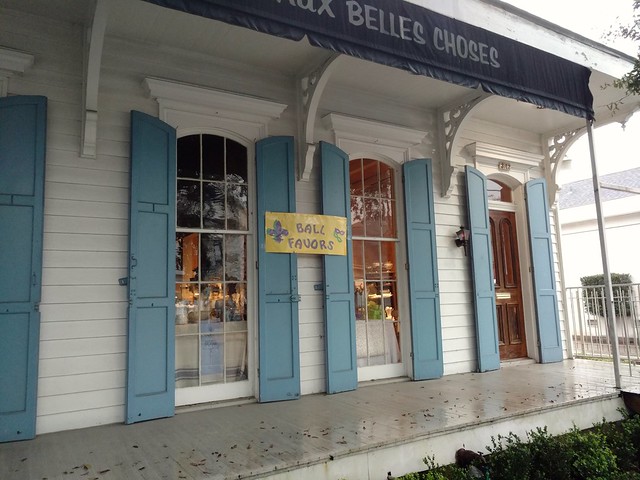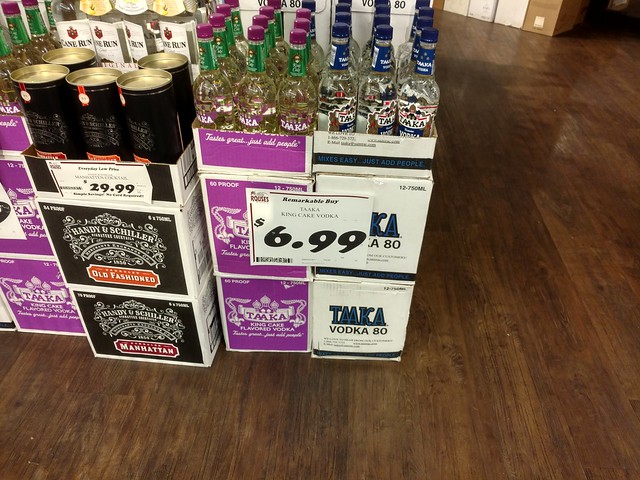Instead we are describing the scene in Armstrong Park last week when a bunch of cops had nothing better to do with their DHS money than go out and LARP their wildest fantasy of such an attack.
The New Orleans Office of Homeland Security and Emergency Preparedness will conduct a "full-scale exercise" simulating an attack on a parade. This important drill will help New Orleans public safety agencies test emergency response plans in the event of a real attack. For example, the simulation will test a hospital surge plan to triage and handle a mass casualty incident. The City's family reunification plan to track and communicate with family members the status and location of people affected by an attack will also be tested through this drill. Role-playing with real people and real equipment allows emergency personnel to fully test plans, policies, and response.Sounds fun! Was it fun? Looks that way. They had actors and props and floats and all kind of neat stuff. Here's the video. It's always reassuring to see the SWAT crew show up in tanks. Really puts you in the Carnival spirit.
The good news is everybody was pleased with the way it went. Emergency responders say they know who to call first and how to get where they need to go in case a drunk driver loses control near a crowd or in case somebody besides a cop fires a gun out there. Both of those things have happened before, of course. Still, it sounds like a lot of these procedures could have been covered in a series of memos and meetings but what would be the fun of that? As for "terrorism," that's not likely to be as much of a concern. That is, unless when police and prosecutors don't want to share exculpatory evidence with defendants. Then there's a terrorist hiding behind every tree. Which is why the trees all have cameras now, probably. Even the floats have eyes.

Anyway, the point of all this is, Happy Mardi Gras! We're already deep into the season and I've already got one sunburn and two moderate hangovers to show for it. But, well, I've gone to all these parades and taken all these pictures so doggone it I'm gonna have to write about it a little bit. In multiple parts, actually. There's always a lot going on during Carnival season and it's already Friday. Let's see how far we can catch up before I have to go out and drink in the street some more.
The New Mardi Gras is over... or is really the Old Mardi Gras.. or..

Krewe of 'tit Chewbacchus rolling on through
Thanks, in part, to the late Carnival season... and probably to police paranoia as well... the parade schedule got shuffled around a bit this year. The most significant change saw Chewbacchus moved from the first big Saturday night, all the way up to a week ahead of Krewe Du Vieux. On the one hand this is probably bad in that it's yet another concession to the city's stupid insistence on supporting only one parade route at a time. On the other hand, maybe Chewbacchus really does belong in the pre-season.
After all, Chewbacchus does have a lot in common with the other small scale parades and street happenings that go on in the weeks before the major parades roll. NOLADotCom art critic Doug MacCash erroneously lumped them together with a few other recently formed parades and marching clubs into something he calls "New Mardi Gras." But there are all sorts of problems with this appellation chief among them being the fact that there's nothing particularly new about the format any of these groups present. Small, independent, maskers and marching clubs have always been a part of Carnival. In fact, the tradition is older than the larger parade style introduced to New Orleans by Comus in the 19th Century. We have other nits to pick with MacCash on this point but a lot of this ground was covered on the last Hunkerdowncast which you can listen to here if you really want to get into it. Probably the most thoughtful discussion of Chewbacchus and its place in the Carnival continuity came from this Jules Bentley article in 2015.
I'm still not clear on MacCash's motivation, though. A lot of the time it seems like he's deliberately trolling trolling on behalf of the treps and transplants who do, in fact, comprise much of the Chewbacchus membership. Maybe he's sympathetic to the club's libertarian ethic. Or maybe he just knows this is thing that will get a rise out of people. Just ahead of Chewbacchus, Doug ran with speculation sourced to one of the Krewe's "Overlords" about the possibility of carrying ads in the parade.
This year, for the first time, the Chewbacchus parade may include banners or other advertisements for local breweries and distilleries that are sponsors of the krewe. A city ordinance prohibits advertisements of any kind during the officially designated Carnival Parade Season (from the second Friday before Mardi Gras, through Mardi Gras day). But Overlord Ethridge points out that since the Chewbacchus parade falls outside of those dates, it’s legal to display ads.That touched off the predictable half day or so of yelling on Twitter until someone could follow up with the krewe to discover that, no, they weren't really serious. Was that what MacCash intended? or was it just a stupid accident? Maybe we'll never know. Sound off in the comments.
Anyway, she said, Chewbacchus is actually a church that venerates the “Sacred Drunken Wookiee.” So alcohol is a sort of sacred sacrament and therefore alcohol ads are simpatico.
Rex dumped Kern

Fancy shop sells fancy things to fancy people
This is going to be the last year of the longstanding relationship between the King Of Carnival and his float builder. They will celebrate the occasion by staring into the sun together.
After this Mardi Gras, a different float-building company will take on the Rex parade floats after the Rex Organization and Kern Studios decided to end their partnership, according to a WWL-TV report.The WWL story doesn't pin down a reason for the split. We do know the Kern family isn't quite as stable as it once was but to say anything on top of that would be speculating. Also I couldn't help notice we got some comments from "Rex Organization official James Reiss."
Kern Studios has constructed the King of Carnival's floats for more than 65 years. After this year's Rex parade rolls with the theme "Visions of the Sun," another company will take on the task for at least the next five years, WWL-TV reported.
"We're extremely proud to for 68 years to have had the backing of Kern artists in creating what we think is one of the premier parades during N.O. carnival," said Rex Organization official James Reiss. "As all business relationships do, they mature. We're extremely proud that Kern has now taken New Orleans Carnival not just to other krewes but internationally to places like China, to Universal Studios. As they have grown, we think that we've been a big part of that growth. We're happy to see what they've done. It's just time for the two organizations to move on. It's really just an internal business decision. We're both very good friends and will remain so."Yeah, well, good for them. The thing is, we can't let Reiss's name pop up without mentioning again his role, and that of his peers, in realizing the vision of a new New Orleans, Reiss so helpfully laid out for us in the days after Katrina.
More than a few people in Uptown, the fashionable district surrounding St. Charles Ave., have ancestors who arrived here in the 1700s. High society is still dominated by these old-line families, represented today by prominent figures such as former New Orleans Board of Trade President Thomas Westfeldt; Richard Freeman, scion of the family that long owned the city's Coca-Cola bottling plant; and William Boatner Reily, owner of a Louisiana coffee company. Their social pecking order is dictated by the mysterious hierarchy of "krewes," groups with hereditary membership that participate in the annual carnival leading up to Mardi Gras. In recent years, the city's most powerful business circles have expanded to include some newcomers and non-whites, such as Mayor Ray Nagin, the former Cox Communications executive elected in 2002.Yeah, well, good for them, too. They got everything they wanted. The schools are all charters, the "demographics" have shifted, the city is smaller, whiter, and fewer poor people can afford to live here. And, from the looks of things, our political leadership is fairly satisfied with that. This week, the City Planning Commission considered the results of a study on affordable housing set asides that appears to recommend taking little or no action.
A few blocks from Mr. O'Dwyer, in an exclusive gated community known as Audubon Place, is the home of James Reiss, descendent of an old-line Uptown family. He fled Hurricane Katrina just before the storm and returned soon afterward by private helicopter. Mr. Reiss became wealthy as a supplier of electronic systems to shipbuilders, and he serves in Mayor Nagin's administration as chairman of the city's Regional Transit Authority. When New Orleans descended into a spiral of looting and anarchy, Mr. Reiss helicoptered in an Israeli security company to guard his Audubon Place house and those of his neighbors.
He says he has been in contact with about 40 other New Orleans business leaders since the storm. Tomorrow, he says, he and some of those leaders plan to be in Dallas, meeting with Mr. Nagin to begin mapping out a future for the city.
The power elite of New Orleans -- whether they are still in the city or have moved temporarily to enclaves such as Destin, Fla., and Vail, Colo. -- insist the remade city won't simply restore the old order. New Orleans before the flood was burdened by a teeming underclass, substandard schools and a high crime rate. The city has few corporate headquarters.
The new city must be something very different, Mr. Reiss says, with better services and fewer poor people. "Those who want to see this city rebuilt want to see it done in a completely different way: demographically, geographically and politically," he says. "I'm not just speaking for myself here. The way we've been living is not going to happen again, or we're out."
Forcing developers to add lower-cost apartments to their residential projects would be difficult to implement outside of New Orleans' most sought-after neighborhoods, and it likely would create only a few dozen lower-priced units per year, according to a study commissioned by the City Council.As we've pointed out numerous times here, inclusionary zoning and developer incentives aren't going to protect our neighborhoods from displacement and gentrification anyway. To do that we need to build actual public housing and, very likely, to implement some sort of rent control policy. By admitting that "the market" isn't going to solve the problem for us, this study actually confirms this. That isn't what the CPC wants to hear, of course. And it's certainly not what they'll hear from any of the Rex Organization men. Maybe if something happened to displace them from their homes they might finally be able to empathize just a little bit. But probably not.
The local housing market is strong enough to support an affordable-housing mandate, known as "inclusionary zoning," only in areas such as the Central Business District and the French Quarter, said the study, a summary of which was released Tuesday.

A black wreath lain on the fencepost at the now ruined Downman Mansion. Rex is still going to stop here on Fat Tuesday.
There's all kinds of king cakes now

Also available in vodka form
King cakes used to be such a prime topic for hot takes. Do you eat them out of season? Do you like them filled or plain? Should the baby come in the cake or separately in the box? Is your neighborhood bakery doing it wrong?
Most recently, I think, the thing that got everyone excited was the Dong Phuong fad and associated manufactured scarcity. But I think it's time to declare that over now. There also was a time when everyone enjoyed freaking out over the newest weird flavor with like... tomato sauce and pretzels on it or whatever. But the process of one-upsmanship has become so baroque now that there are a million varieties and none of them can stand out anymore. Do whatever you want with your king cake. Nobody is shocked. Nothing matters.
The only sane move is to stick to basics. So in light of that, here is a perfectly cromulent king cake guide from NOLA.com. These are all good recommendations. I am still partial to Antoine's, though.
City government is saving Mardi Gras but also it is ruining Mardi Gras

A civilization rises on Napoleon Avenue
God bless Mayor Cantrell. She has picked up and expanded on the previous administration's recent emphasis on reminding parade goers to share the public space and not obstruct it with too many ladders and tents and chairs and such. We here at the Yellow Blog have observed this problem closely for many years. We've even appeared in the local media from time to time advocating for change. It's gratifying to see the city take it seriously.
They've made it a major point in the annual get-ready-for-Carnvial press conference.
The city will also be taking a hard line against those who leave items on the parade routes to try to reserve preferred spots.The "will be destroyed" comment got a lot of attention this week because LaToya repeated it as city workers charged down the St. Charles Avenue neutral ground making good on the threat. But it's worth noting this was the policy from the outset. Anyway the beatings will have to continue until morale improves because people really do need to be forcefully reminded about these issues every year. My personal observation has been that, while the enforcement effort has done some good, it hasn't obviated the problem entirely. This week, the parade route is still tightly walled with tents, ladders, and those dang festival chairs that seem to get worse every year. If people would just put them in the back where they belong everyone would be able to move around and..... well, you've heard all this from me before.
Workers will clear away items such as tarps and ladders left along the routes, Parks and Parkways Director Ann McDonald said.
"We will not store items," she said. "We will not tag items. Any items that we remove will be destroyed.”
A few weeks ago, this story got passed around about a guy offering to camp out and "save a spot" for on the neutral ground. 10 ft. by 10ft. for $2,000! This is supposed to be a free and open public celebration. We can't allow the very public spaces dedicated to that purpose become walled off and monetized.
There is something else the city could do to decrease the high demand for real estate. The city could allow the party to spread back out into the neighborhoods it once belonged in rather than bottle it all up along one corridor like the over-leveed Mississippi River. One reason the St. Charles route is crowded beyond capacity with campers and ladders is it's more or less the only place anyone can go to catch a parade anymore. It wasn't always like this as a recent Gambit commentary noted.
Older New Orleanians remember seeing the krewes of Endymion and Pontchartrain rolling through Gentilly and New Orleans East, respectively. The Krewe of Mid-City's unique, foil-wrapped floats once used to delight people in … Mid-City. And the Krewes of Freret and Carrollton used to roll down (you guessed it) Freret Street and Carrollton Avenue, respectively.We could move a few parades back to their neighborhoods. But the city doesn't want that. The police don't want it. But the police and Homeland Security don't think we should be doing any of this in the first place and only tolerate it insofar as it benefits the tourism industry. But our holidays are about more than the most crass and efficient means of turning a profit. We're never going to put things right if all we do is listen to the police and wealthy few they serve and protect. And we're never going to solve the route overcrowding problem until we see that.
The concentration of parades on St. Charles Avenue makes things easier for the city, especially for our manpower-challenged police department, but it has taken something away from New Orleans' neighborhoods. Carnival season is a party we put on for ourselves, and it's time to ask: Can we move a few parades back to their neighborhoods?
More Mardi Gras Guide to come:
Part 2: Racism, politics, and Carnival con artists
Part 3: The parade ratings matrix
No comments:
Post a Comment